Using AVI Trimmer+
In this section:
- Opening a source file
- Using the splitting controls
- Saving a media file
- Starting the trimming process
- Working with the batch queue
- Working with MPEG-2 files
Opening a source file
Operations with files are performed via the menu bar in AVI Trimmer+.
To open a source file, go to the menu bar, select File -> Open Media File... Select your video file in standard Open dialog box. This file will not be changed, deleted or moved during the splitting process. You can also drag-and-drop file from any folder to Video Splitter main window or use "Input" button to open the file.
See also: File menu
Using the splitting controls
Before you start the trimming process, you should define the fragments you want to be cut or kept in the output file.
To add a new fragment to the slider:
- Navigate to the beginning of the future fragment
- Press the Add begin marker key (N) or select the Edit -> Add Begin Marker menu item from the menu bar
- Navigate to the end of the future fragment
- Press the Add end marker key (M) or select the Edit -> Add End Marker menu item from the menu bar
- Set the fragment type by selecting Edit -> Cut Off Selected Fragment (D) or Edit -> Keep On Selected Fragment (S)
- If you need to change the start or stop fragment positions, just drag the markers to their new positions

Sample fragments
| Fragment color | Description |
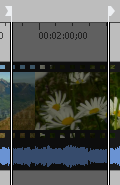 |
This fragment is set to be deleted. It will not be present in the final movie |
 |
This fragment is set to be kept. It will be present in the final movie |
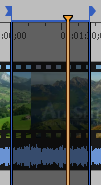 |
This fragment is set to be deleted. It will not be present in the final movie. The blue color means you can edit it (delete, set it to be kept, etc.) |
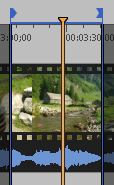 |
This fragment is set to be kept. It will be present in the final movie The blue color means you can edit it (delete, set it to be cut, etc. ) |
| Window Item | Description | Shortcut key |
 |
Add Begin Marker: Add a new begin marker to the current slider cursor position. | N |
 |
Add End Marker: Add a new end marker to the current slider cursor position. | M |
 |
Set audio silence: allows to set audio silence for the chosen fragment | |
 |
Start: Start trimming | Ctrl + T |
 |
Cursor time position. You can edit this value manually | |
 |
Zoom In/Out: Increase/decrease the slider timeline resolution to make editing neighbouring markers more comfortable | NumPad + |
 |
Story board Off/On: turn on/off the story board | |
 |
Audio waveform On/Off: turn off/on the audio waveform | |
 |
Get screenshot: allows to make the screenshot of the chosen video frame | |
 |
Browse screenshot: allows to open folder with the created screenshot |
Context menu of splitting controls consists of the following commands:
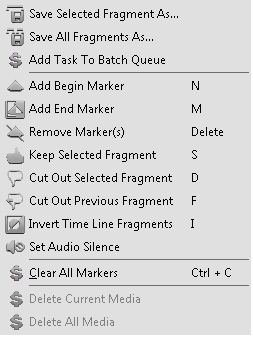
| Menu Item | Menu Description | Shortcut key |
| Save Selected Fragment As... | Allows to save selected fragment |
Page Down |
| Save All Fragments As... | Allows to save all marked fragments | Del |
| Slicing | Opens Slicing window | Page Down |
| Add Task to Barch Queue (*) | Allows to add Task to Batch Queue (*) | A |
| Add Begin Marker |
Add a new begin marker to the current slider cursor position. | N |
| Add End Marker |
Add a new end marker to the current slider cursor position. | M |
| Remove markers |
Remove all markers from the timeline | Delete |
| Keep Selected Fragment |
Allow to keep selected fragment. | S |
| Cut out selected fragment |
Allow to cut out selected fragment | D |
| Cut out previous fragment |
Allows to cut out previous fragment | F |
| Invert Time Line Fragments |
Allows to invert timeline fragments. | I |
| Set audio silence |
Allows to set audio silence on the selected fragment | |
| Clear All Markers |
Allows to delete all markers from the timeline | Ctrl + C |
| Delete Current Media |
Allows to delete current media file from the timeline (*) | |
| Delete All Media |
Allows to delete all media files from the timeline (*) |
(*) - The feature is supported only in the paid product SolveigMM Video Splitter Business Edition
Starting the trimming process
To start the trimming process after you set all the fragment you want to be deleted/saved, select File -> Save Media File As... (for details, see File menu) or click the Save Media File As.. quick button or click the Start button (for details, see Splitting controls)
Note: You can save (trim) any selected fragment using the Save Selected Fragment As.. item from the slider context menu (for details, see Splitting controls)
Working with the batch queue
Note: The Batch Manager is supported only in the paid product SolveigMM Video Splitter Business Edition.
To create a new batch queue (task list):
- Open the media file you want to edit, set all the fragments you want to be saved/removed. For details, see Opening source file and Solveig Multimedia Video Splitter interface
- Add the task to the queue. To do it, select Tools ->Batch Manager ->Add Task To Batch Queue
- Repeat steps 1 and 2 for all the files you want to process.
See also Tools menu, Keyboard shortcuts
Also, you can add a task to the queue by selecting File -> Save Media File As... from the menu, or selecting the Save selected fragment as.. item from the slider context menu (for details, see Splitting controls). You should select the Don't start now. Add the task to batch queue instead checkbox:
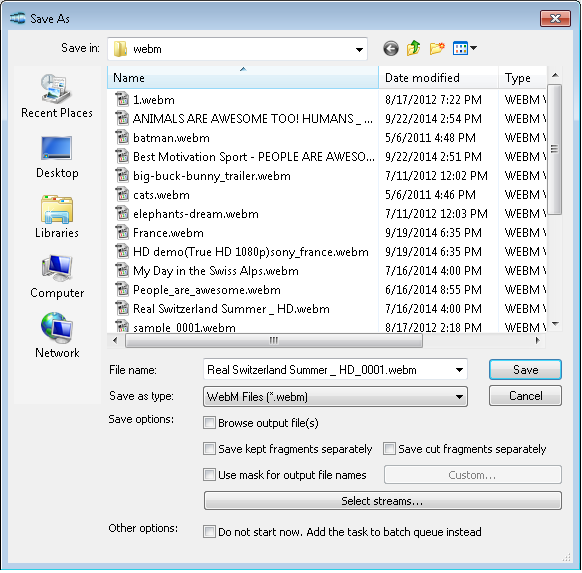
To open the Batch Manager window, select Tools -> Batch
Manager -> Show Batch Manager on the menu or select Tools
-> Batch Manager -> Load Task List... to open a task list
file.
The Batch Manager window allows you to change audio/video streams, the
Obey samples times attribute, delete any fragments, etc. For
details, see Tasks queue field.
To edit a task, you have to open it in AVI Trimmer+, change its
fragments or settings and update it:
- Select the task you need to edit. Select the Edit -> Edit Task with Video Splitter menu item or the Edit Task with Video Slitter item from the context menu or press the Enter hot key. For details, see Tasks queue field, Keyboard shortcuts
- Edit the task in the AVI Trimmer+ main window. To view the existing fragments in AVI Trimmer+, you can use the Fragment list field. To do it, select Show the Fragment in Video Splitter from the context menu or press the Enter hot key. For details, see Keyboard shortcuts
- After you edit the trimming settings in Video Splitter, update the task in the batch queue by selecting the Tools -> Batch Manager -> Update Task menu item or the Edit -> Update Task item in the Batch Manager window.
Working with MPEG-2 files
Note: The editing of MPEG-2 files is supported only in the paid product SolveigMM Video Splitter.
This section describes how to use SolveigMM Video Splitter with MPEG-2 video.
Open the MPEG-2 video file you want to split:
Select File -> Open Media File... from the menu.
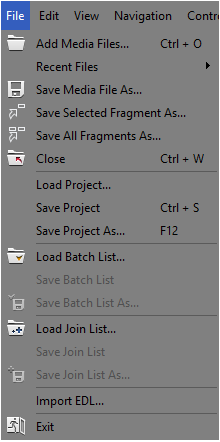
The standard Windows Open File dialog box will appear.
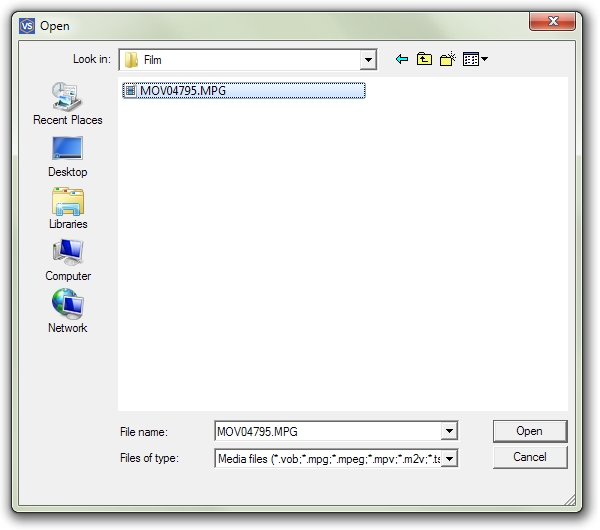
Select the video file and click Open.
Note. Indexing the MPEG file is recommended but not required.
With no index, you will not be able to use K-Frames and the trimming process can be inaccurate. You could enable/disabple option in the Preferences -> Control tab to "Index MPEG audio" or "Index MPEG video files".
If you cancel the indexing process or choose not to index the file, you can index it later in the following way: select Tools -> Index MPEG file in the folder or Tools -> Index MPEG files from Media list from the menu.
If MPEG2 file contains several video or audio tracks then the Stream selection window will be opened.
It contains two tabs: Programs and Tracks, where you can select the desired stream by clicking the icon near the appropriate stream.
The icon with an eye ( ) shows what stream is selected for preview.
) shows what stream is selected for preview.
The icon with the scissors ( ) shows what stream is selected for editing.
) shows what stream is selected for editing.
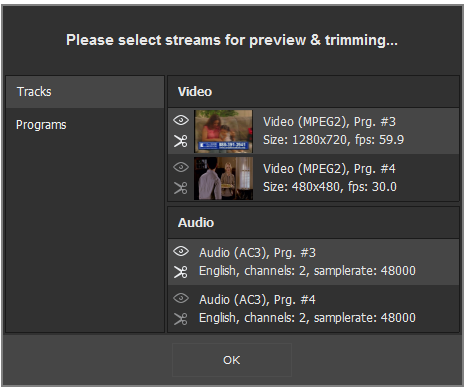
| Item of Window | Description |
 |
The stream is selected for preview |
 |
The stream is selected for editing. It will be saved in the output file. |
 |
The stream is not selected for preview |
 |
The stream is not selected for editing. It will not be saved in the output file. |
What to do next is described in How-to section.
